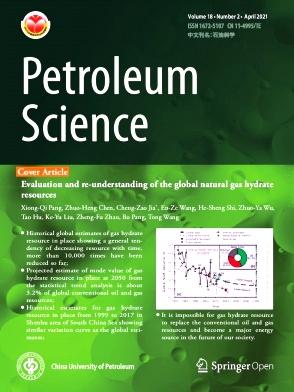低对比致密砂岩储层流体识别和饱和度计算新方法
IF 6
1区 工程技术
Q2 ENERGY & FUELS
引用次数: 0
摘要
在低反差致密砂岩储层中,油气层与水层之间的电阻率差异非常微妙。基于传统测井方法的流体识别和饱和度计算在这类储层中面临挑战。本文提出了一种在低反差致密砂岩储层中进行流体识别和饱和度计算的新方法。首先,构建了表观地层水电阻率计算模型,该模型考虑了页岩对电阻率计算的影响,避免了表观地层水电阻率异常值的出现。根据新模型得到的视地层水电阻率分布,确定了低对比致密砂岩储层的水谱,用于流体识别。随后,根据水谱的平均值、标准偏差和端点,建立了计算储层油气饱和度的四参数新模型。本文提出的方法被应用于中国松辽盆地南部 X53 区块和 X70 区块 Q4 地层中的低对比致密砂岩储层。结果表明,水光谱方法可以有效地区分油水层和水层。油水层的水光谱标准偏差普遍大于水层。新的四参数模型可获得更准确的油气饱和度。这些发现验证了拟议方法的有效性。本文章由计算机程序翻译,如有差异,请以英文原文为准。
A new method for fluid identification and saturation calculation of low contrast tight sandstone reservoir
The resistivity difference between oil and gas layers and the water layers in low contrast tight sandstone reservoirs is subtle. Fluid identification and saturation calculation based on conventional logging methods are facing challenges in such reservoirs. In this paper, a new method is proposed for fluid identification and saturation calculation in low contrast tight sandstone reservoirs. First, a model for calculating apparent formation water resistivity is constructed, which takes into account the influence of shale on the resistivity calculation and avoids apparent formation water resistivity abnormal values. Based on the distribution of the apparent formation water resistivity obtained by the new model, the water spectrum is determined for fluid identification in low contrast tight sandstone reservoirs. Following this, according to the average, standard deviation, and endpoints of the water spectrum, a new four-parameter model for calculating reservoir oil and gas saturation is built. The methods proposed in this paper are applied to the low contrast tight sandstone reservoirs in the Q4 formation of the X53 block and X70 block in the south of Songliao Basin, China. The results show that the water spectrum method can effectively distinguish oil-water layers and water layers in the study area. The standard deviation of the water spectrum in the oil-water layer is generally greater than that in the water layer. The new four-parameter model yields more accurate oil and gas saturation. These findings verify the effectiveness of the proposed methods.
求助全文
通过发布文献求助,成功后即可免费获取论文全文。
去求助
来源期刊

Petroleum Science
地学-地球化学与地球物理
CiteScore
7.70
自引率
16.10%
发文量
311
审稿时长
63 days
期刊介绍:
Petroleum Science is the only English journal in China on petroleum science and technology that is intended for professionals engaged in petroleum science research and technical applications all over the world, as well as the managerial personnel of oil companies. It covers petroleum geology, petroleum geophysics, petroleum engineering, petrochemistry & chemical engineering, petroleum mechanics, and economic management. It aims to introduce the latest results in oil industry research in China, promote cooperation in petroleum science research between China and the rest of the world, and build a bridge for scientific communication between China and the world.
 求助内容:
求助内容: 应助结果提醒方式:
应助结果提醒方式:


